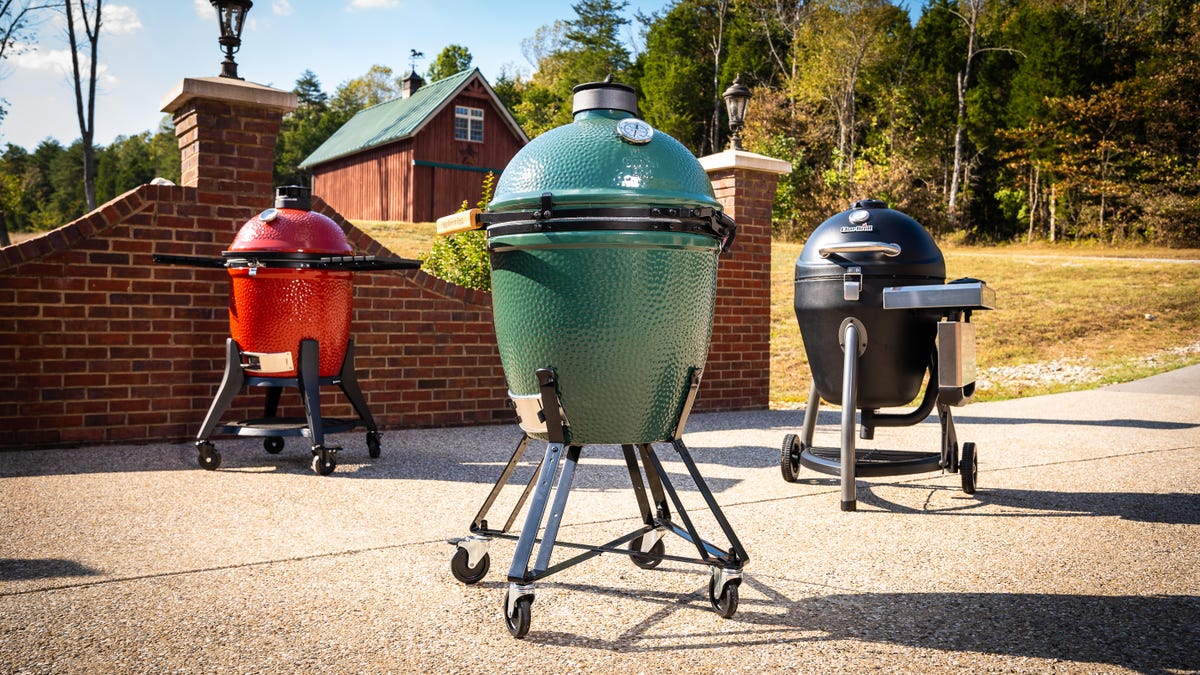
A kamado grill will almost always outshine a standard gas grill. While it may take a bit of practice to master the kamado grill and these grills are usually a little more expensive, they’re definitely worth the investment. Kamado grills are known for wood-fired cooking — a technique that consistently yields the most delectable results.
Typically made from ceramics, these grilling champs boast amazing heat retention. A little amount of fuel goes a long way, allowing you to run a kamado cooker at slow and low temperatures all day long. Plus, you can fire up a kamado to become scalding hot. I’m talking hot enough to cook authentic wood-fired Neapolitan pizza. A kamado grill is also great for searing true steakhouse-style steak and, honestly, just about anything you’d consider grilling.
The Big Green Egg is the most high-profile example of a traditional kamado grill and kamado smoker, but rival kamado manufacturers such as Kamado Joe, Char-Griller, Vision and Char-Broil round out this category of grills. Tempted to add one to your outdoor kitchen arsenal and become a hardcore griller? I put the Big Green Egg and its four major grilling competitors to the test to find the best kamado grill out there — here’s what I found.
Ribs, chicken, burgers: You name it, we cooked it.
More than 200 smoke-filled hours later, I’ve cooked over 10 pounds of burgers, 20 pounds of pork ribs and six chickens, along with a few steaks for good measure. After all of that, I can say with conviction which brands make the best kamado grill for my taste and which ones you should probably avoid.
Here are my picks for the best kamado grill options for 2023. I’ll update this list as I review new products.
Best kamado grills
Big Green Egg, the company that started the kamado craze, still has a winner. Of all the kamado-style grill options in my test group, the Large BGE model had the best temperature performance, heat retention and stability. Once tuned to a low and slow temperature of 225 F, the Egg pretty much ran itself. According to our temperature gauge, the Green Egg stuck to this temperature range, with only minor and infrequent fluctuations.
The Char-Griller Akorn provides real kamado performance at a rock-bottom price. It costs less than $350, which is incredible considering typical kamado grills will set you back $800 to $1,000. The Akorn’s cooking temperature and temperature control aren’t as inherently stable as the more expensive kamados I used. I suspect that’s because the Akorn’s body is constructed from triple-walled coated steel, as opposed to a heavy ceramic cooker. The grill’s fire was also harder to ignite and keep lit than the Big Green Egg’s and Kamado Joe Classic III’s.
The Kamado Joe Classic III may have a steep price, but it delivers plenty for the money. That means lots of kamado grilling accessories that don’t come standard with other grills, including the Big Green Egg Kamado. This kamado grill and smoker performs well too. In our slow-and-low barbecue grill test, we adjust grills to 225 F (107 C) and let go of the controls to see what happens. In this trial, the Kamado Joe Classic III demonstrated excellent temperature control.
How we test kamado grills
Testing kamado grills is an intense experience for a griller. It requires playing with fire (literally) and high temperatures, though in a controlled, responsible way. The most critical element to kamado performance is heat, specifically temperature control and how well a grill holds to one temperature. To smoke meat low and slow, that magic number is 225 F. Good smokers, kamados or otherwise, will stick to this temp for as long as 12, 15 or 20 hours. This means the temperature gauge is key and so is the ability to control airflow via air vents or dampers.
We monitor the internal temperature of the kamado grills as they go.
To capture temperature data, we put a thermocouple on each kamado grill. Essentially a sensitive temperature sensor made of a probe and a connected wire, the thermocouple hangs suspended just 1 inch above the grill grate. It’s connected to a data logger and ultimately a computer that records changes in heat levels over time.
Then it’s time to fire up each grill.
We try to run temperature tests on all the grills simultaneously. We also use the same weight and brand of lump charcoal (4.4 pounds or 2 kg), often from the same bag. That’s true of fire starters, too (one per grill).
A stable heat level is key to good performance for a kamado smoker.
After that, we light them up, as instructed by their manuals if available. Usually that means letting the coals catch for 15 minutes, with the lid open, then shutting the grill. At this point, vents remain wide open until the grill comes within 50 degrees of the target temp.
We carefully fiddle with the vents to get there. Lastly, we let go of the controls and observe.
We follow the same procedure for our higher-temperature test with a target of 350 F. The idea here is to simulate the heat performance required to roast chicken and other poultry.
We smoke ribs along with other food for anecdotal tests.
And speaking of food, we perform lots of “anecdotal tests” too. We smoke a rack of baby back ribs (225 F) in each grill. We butterfly (aka spatchcock) chickens and roast them too. Sourced from the local Costco, these weigh roughly 5 pounds each. Last, we grill a set of four 8-ounce burger patties at high heat (600 F).
Burgers, anyone?
Want more options? Here are the other two kamado grill models I evaluated for this test group. While they didn’t make it into my picks, you may want to take a look for comparison’s sake:
Watch this: Testing gas grills at the CNET Smart Home
More grilling recommendations
